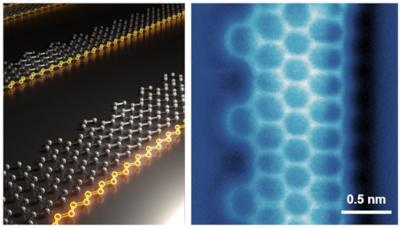Unique GNRs could advance quantum technologies
Researchers from the National University of Singapore (NUS), working with teams from University of California, Kyoto University and others, have reported a breakthrough in the development of next-generation graphene-based quantum materials, opening new horizons for advancements in quantum electronics.
An atomic model of the Janus graphene nanoribbons (left) and its atomic force microscopic image (right). Image credit: NUS
The innovation involves a novel type of graphene nanoribbon (GNR) named Janus GNR (JGNR). The material has a unique zigzag edge, with a special ferromagnetic edge state located on one of the edges. This unique design enables the realization of one-dimensional ferromagnetic spin chain, which could have important applications in quantum electronics and quantum computing.






